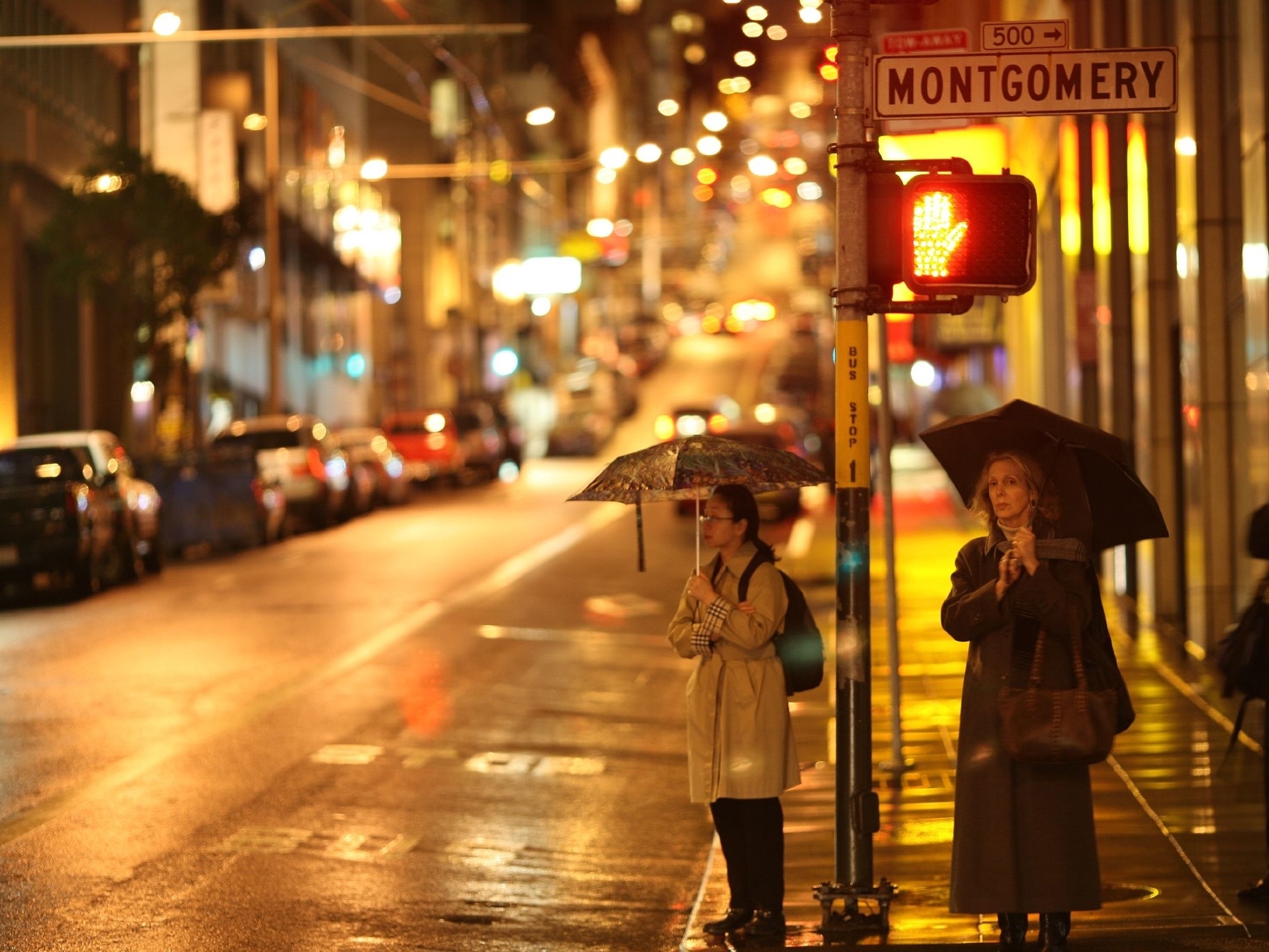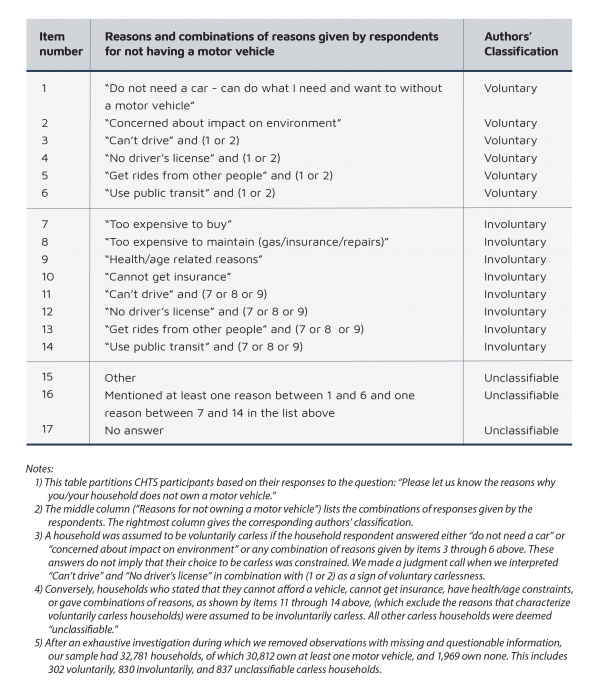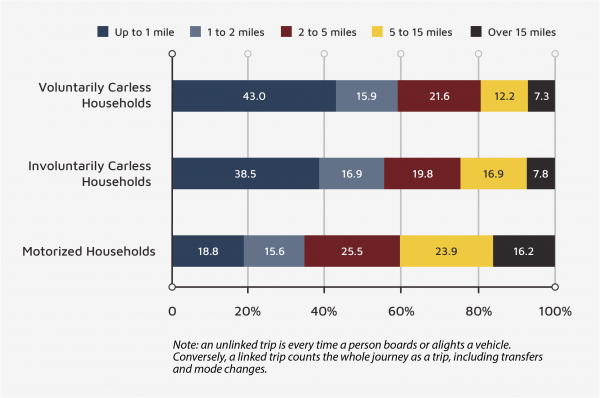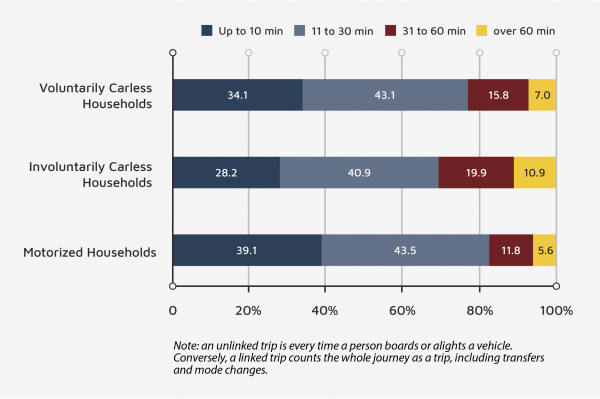
Carless in California: What the Carless Can Tell Us About Shifting Behaviors and Improving Mobility
The road away from an auto-dependent society is a rocky one
About 7 percent of California households do not own motor vehicles. Unfortunately, families without cars, trucks, vans, SUVs, or motorbikes are rarely the focus of transportation research and policies, which typically center more on predicting and managing motor vehicle traffic.
Widespread automobile ownership has shaped our society by enhancing mobility for most, but these benefits have come at the cost of frequent collisions, heavy traffic congestion, substantial carbon emissions, and widespread noise pollution. In 2015, California Gov. Jerry Brown signed an executive order requiring the state to reduce greenhouse gas emissions to 40 percent below 1990 levels by 2030, accelerating goals previously set by Assembly Bill 32 and Senate Bill 375. While these laws and executive orders have turned reducing vehicle-miles traveled into a prominent policy goal, the path away from an auto-dependent society is far from clear. Accordingly, researchers and policymakers can learn a great deal from the households who live without motor vehicles. To do this, we must first distinguish between “voluntarily carless households,” who have chosen to not own motor vehicles, and “involuntarily carless households,” who are carless by necessity. Understanding the characteristics and the travel behavior of households who voluntarily forgo cars can inform policies that aim to reduce our dependence on motor vehicles. At the same time, it is equally important to take into account the characteristics of involuntarily carless households, as they are at risk of social exclusion due to impaired mobility.
Involuntary carlessness has been associated with poverty, which in turn, links it to race, ethnicity, place of birth, and for immigrants, time since arrival in the United States. Some studies show that car ownership is more important to finding employment than even education or job training. Motor vehicle access is also strongly associated with important health-related factors, like doctor’s visits and prenatal care. Because car ownership is so valuable in the United States, some studies show that carlessness is often temporary and ends when families are able to acquire vehicles. Not surprisingly, research shows that walking, cycling, transit use, and getting car rides from others are more prevalent in carless households than in motorized households. When they do travel in motor vehicles, members of carless households most frequently travel for work or personal business, followed by social/recreational and religious activities. New mobility options, such as car and bike sharing programs, appear to be particularly promising for involuntarily carless people, and could facilitate more voluntary carlessness since they provide substitutes for family cars.
Unfortunately, we don’t know a lot about carless households and their travel behavior. To fill this gap, we analyzed data from the 2012 California Household Travel Survey (CHTS). We characterized carless households in California, and assessed the effects of socioeconomic and built environment factors on the likelihood that a household is carless. California is a good place to study carlessness because its diverse population lives in many different types of built environments — rural, urban, and suburban — from the San Francisco Bay Area, where comprehensive transit service is widespread, to Southern California suburbs, where transit is scarce and cars are indispensable.

California is a good place to study carlessness because its diversity — from the San Francisco Bay Area, where comprehensive transit service is widespread, to Southern California suburbs, where transit is scarce and cars are indispensable.

Understanding the carless
Most results reported in this paper come from analyzing data from the 2012 CHTS, which gathered geographically specific travel information from households in all of California’s 58 counties. The data were collected using diaries, computer-assisted telephone interviews, a website, and global positioning system devices. A total of 42,431 households recorded their travel for a pre-assigned 24-hour period, and provided detailed socioeconomic characteristics, locations, and household car ownership status.
To understand whether carless households chose to live without cars voluntarily, we analyzed the CHTS question that asks reasons for not owning a motor vehicle. Respondents who selected either “want to be without a car” or “concerned about [cars’] impact on [the] environment” (items 1 and 2 in Table 1) were assumed to have chosen voluntarily to forgo vehicles, provided they did not select any other answer suggesting that their choice was constrained (e.g., “for monetary, medical, or age reasons”). Conversely, households who could not afford vehicles, could not get insurance, or who had health- or age-related constraints, were deemed involuntarily carless, provided that they did not also give reasons that characterize voluntarily carless households. All other households were deemed “unclassifiable.”
Table 1: Classification of carless households

Following published car ownership studies, we investigated characteristic patterns of both households (income, education level, household composition, and dwelling type) and household heads (Hispanic or Latino status, other ethnicity indicators, age, gender, and immigration status). Since the built environment is an important determinant of car ownership, we also examined factors related to home area population density, land use diversity, and urban design. The nearby availability of public transit was estimated by measuring the share of the regional population that could be reached within 45 minutes via public transit and/or walking. Finally, residential self-selection — the likelihood that carless families choose to live in areas conducive to walking, bicycling, or riding transit — was statistically accounted for as well.
Who are California’s carless?
Households are more likely to be carless if they are African American, less educated, immigrated to California fewer than five years ago, or have many household members. Conversely, households are less likely to be carless if they have higher incomes, belong to the “Silent Generation” (born between 1920 and 1940), or live in a single-family house. Not surprisingly, compared to households with vehicles, carless households tend to live in denser, more land-use diverse, and more walkable areas with better transit service.
Similar factors are associated with households who voluntarily forgo their cars, with a few notable differences. Those with male heads of household are more likely to be voluntarily carless, but neither the age of householders nor the jobs-housing balance in their communities affects the likelihood of voluntary carlessness. Compared to involuntarily carless households, voluntarily carless households are also more affluent and live in more walkable, land-use diverse areas with better transit service. These differences between voluntary and involuntary carlessness suggest that the long-held practice of interpreting not having a car as an indicator of disadvantage without accounting for the fact that some people choose not to own cars may be distorting our understanding of household transportation decision-making.
Although its effects are relatively minor, our results also confirm the presence of residential self-selection — whereby some people choose to live in neighborhoods (such as central city areas) that make it easier to live without a car. Finally, while we find that higher population densities foster more voluntary carlessness, research has long shown that density alone has a relatively small influence on driving, and that other factors often associated with density — such as transit service coverage, neighborhood walkability, and the diversity of local land uses — play important roles in supporting carlessness as well.
Travel patterns of carless households
Figure 1. Linked trip frequency by distance

Figure 2. Linked trip frequency by trip duration

Compared to motorized households, carless households take fewer than half as many trips on average. Their trips are also consistently shorter; median trip distances are less than half as long, with a higher proportion of trips under a mile (Figure 1). Conversely, median travel times tend to be longer for involuntarily carless households than for either voluntary carless households or, especially, motorized households, as walking, getting rides from others, or taking public transit are typically slower than driving (Figure 2). Unsurprisingly, members of carless households ride transit, walk, and bike more than motorized households.
Compared to the voluntarily carless, involuntarily carless households travel farther, albeit less frequently, even though they are slightly less affluent. This is especially the case for trips involving personal business or work, civic, recreational, religious, or social activities. This may be because voluntarily carless households can satisfy more of their needs without traveling as far as they are more likely to live in neighborhoods with mixed land uses that make walking trips easy and convenient. Overall, voluntarily carless households walk and bike more, and depend on motor vehicles and transit less than involuntarily carless households.
The more frequent use of public transit by involuntarily carless households suggests that public transit still largely serves “captive riders” (i.e., riders without good alternatives to public transit), even though recent public transit investments have tended to focus on attracting so-called “choice riders.” Finally, when involuntarily carless household members do use motor vehicles, they tend to carpool more than when those in voluntarily carless households travel by car. Involuntarily carless households may have less flexibility when using motor vehicles because they are less affluent, on average, and thus have more incentive to share vehicles and rides.

The more frequent use of public transit by involuntarily carless households suggests that public transit still largely serves “captive riders,” even though recent public transit investments have tended to focus on attracting so-called “choice riders.”

Overall, involuntarily carless households appear to be less mobile than voluntarily carless households. Their trips tend to take more time and they often travel farther. These travel patterns, which planners typically interpret as symptoms of transportation disadvantage, may contribute to more social exclusion and diminished well-being among those in involuntarily carless households.
Assisting the involuntary carless and promoting voluntary carlessness
In the short term, there is no simple solution for improving the mobility of involuntarily carless households because access to motor vehicles is key to quality mobility in most of California. Financial assistance for families to acquire motor vehicles is an obvious remedy, and numerous evaluations of vehicle access assistance programs have found them to be effective for helping low-income travelers. Effective or not, such programs can prompt concerns that helping the involuntarily carless increase motor vehicle access will contribute to greenhouse gas emissions, air pollution, and traffic congestion. At the same time, restricting the poor from the auto-mobility benefits enjoyed by more affluent Californians is an inequitable way to meet important environmental objectives.
Improving transit services could make carlessness more appealing by bolstering the mobility of carless households. However, this strategy’s financial viability often hinges on high population and job densities where public transit works best. Furthermore, transit improvement projects can often draw opposition from community groups, not to mention resistance to the costs of transit implementation and the potential impacts on car throughput. To maximize the effectiveness of transit, these measures could be coupled with policies that promote affordable housing in denser, mixed-use environments, which encourage walking and bicycling. As a result, carless households would not have to travel as much to fulfill their needs.
Transportation planners in California should review experiences in Europe, Japan, and Australia, where voluntary travel behavior change programs provide information, assistance, and incentives to entice people to switch to greener, more active modes. These “soft policies” often feature information campaigns about the health benefits of active modes or the negative environmental impacts of driving, along with real-time information for personal travel planning, convenient e-ticketing, and discounted or free public transportation passes. “Hard policy” alternatives include infrastructure changes, implementing road and parking pricing, as well as higher levels of vehicle taxation. In Denmark, for example, the registration tax for a new car varies between 85 and 105 percent of the purchase price. The Danish government has also consistently invested in public transit and bicycling infrastructure, in addition to implementing voluntary travel behavior change measures. As a result, approximately one third of Danes bike to work, and almost half of Danish children ages 11 to 15 bike to school. Apart from substantial environmental benefits, the health effects of these high bicycling rates have been estimated to reduce annual sick days by 1.1 million per year in Copenhagen alone. Large behavioral changes in California on the scale needed to provide equitable mobility options for carless individuals and achieve greenhouse gas reduction targets will likely require both soft and hard policies.
The development of shared transportation options, coupled with the emergence of self-driving vehicles, could also enhance the mobility of carless households, especially those who are involuntarily carless. In particular, bike sharing and affordable car sharing programs could begin to address transportation disadvantage in urban environments. Car sharing would become even more attractive if self-driving technology were to substantially cut its cost, disconnecting vehicle ownership from mobility. The timing of this potential revolution is highly uncertain, but today’s carless households could be harbingers of the future to a greater extent than they are relics of the past.

Acknowledgments
The authors are deeply grateful to professor Martin Wachs and the editorial team of Transfers Magazine for their editorial help, which substantially enhanced the readability of this paper for non-technical readers.